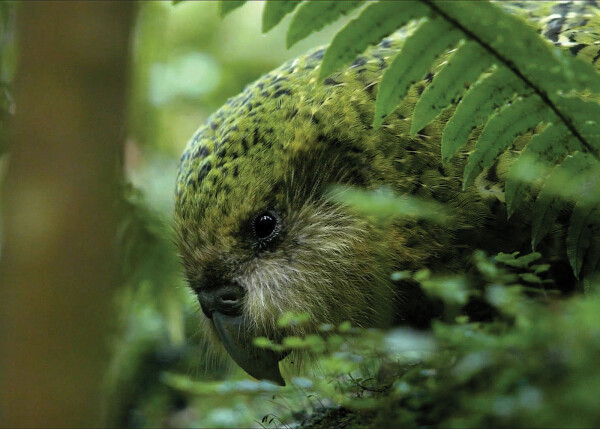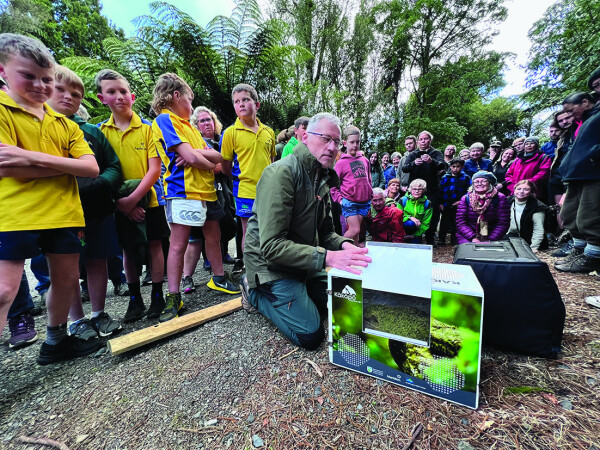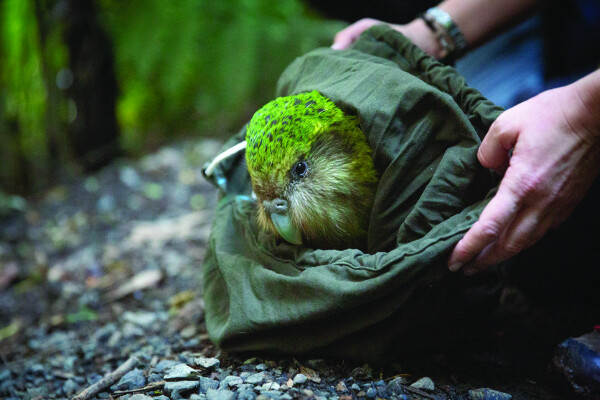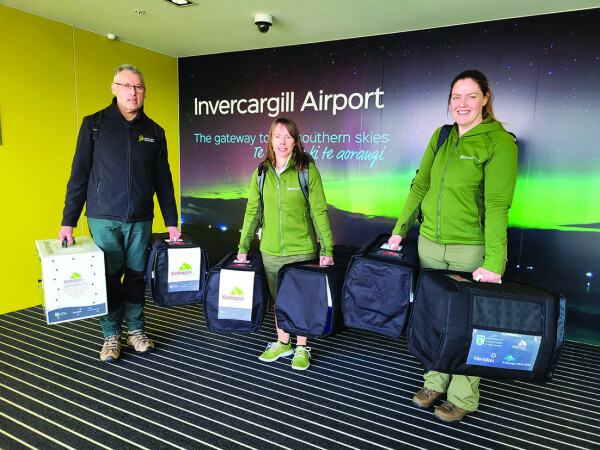Saving the Kākāpō
Mar 20, 2024

Nā Puawai Swindells-Wallace
 Kākāpō are a threatened species that faces immediate risk of extinction. They are also one of 54 birds listed as taoka species in the Ngāi Tahu Settlement Claims Act 1998.
Kākāpō are a threatened species that faces immediate risk of extinction. They are also one of 54 birds listed as taoka species in the Ngāi Tahu Settlement Claims Act 1998.
Taoka species feature in sections 287-296 of the Ngāi Tahu Settlement Claims Act 1998, which ensures that Kāi Tahu have mechanisms under the law to be acknowledged, consulted, and involved in the management and decision-making of all taoka species within the claim area.
Kākāpō get their name according to their active lifestyle at night, kākā referring to parrot and pō to the night. They have an owl-like face and are the world’s heaviest parrot, weighing up to 4kg. Good runners, they use their wings to balance when climbing trees and vines. Males make loud booming sounds throughout the night to attract females. Ripe rimu fruit triggers the kākāpō breeding season. Higher amounts of fruit bring a superior season and kākāpō chicks rely on this fruit as a food source for their first six months, feeding exclusively on regurgitated rimu fruit gathered by their mother each night.
For the past 18 years, Tāne Davis (Ōraka-Aparima) has worked as the Kāi Tahu representative on the Kākāpō Recovery team. He carries the memory of kaumātua who saw the need for Kāi Tahu representation on taoka species recovery groups during the settlement claim process.
As a taoka species representative, Tāne has spent a lot of time with kākāpō, sharing that they have a unique smell, their feathers and colour mimic their surroundings, and that they carry a mauri and wairua you can feel when in their presence. Fifteen years ago, the team predicted the need for more habitats and the idea to look outside the Kāi Tahu takiwā was put forward.
Kākāpō first evolved millions of years ago and could be found nationwide. Habitat is now scarce and became limited to four offshore islands in Te Waipounamu. This year, Tāne accompanied kākāpō from Whenua Hou in the Kāi Tahu rohe to Maungatautari, which is under the mana of Ngāti Koroki Kahukura, Ngāti Hauā, Tainui and Waikato-Maniapoto and Ngāti Raukawa. These hapū and iwi were approached and asked if kākāpō from Kāi Tahu could be whāngai of Sanctuary Mountain.
“It really arrived sooner than we had anticipated. The La Niña weather patterns assisting with mass rimu fruiting meant good breeding seasons and habitat were needed faster than the team had expected,” says Tāne.
The process of releasing taoka from the Kāi Tahu takiwā to the hapū and iwi of Maungatautari was extremely significant, creating an exchange of kawa, tikaka and mātauraka. It was also important to preserve the whakapapa of translocated manu as the diversity of kākāpō genetics is deficient. There are two surviving genetic strains from Fiordland and Rakiura – the last two places in the country to see wild kākāpō. Tāne suspects our tīpuna likely used kākāpō to trade in the past. The recent translocation in July 2023 marks a different type of trade which will help preserve living manu.

Tāne Davis at the kākāpō release in Maungatautari, Sanctuary Mountain.
It involved four male kākāpō, which bought the total population of Sanctuary Mountain to 10. They have been described as unsuspecting, trailblazing males who will enter the protection of local mana whenua. The team has already learnt a lot from these ground dwellers at their new 3000-hectare home, including the need to adapt the fence after three kākāpō scaled it and escaped.
These three curious kākāpō were juveniles and have since returned home to Fiordland, leaving seven at Sanctuary Mountain. Maungatautari is the largest predator-fenced habitat in Aotearoa and is the only option as kākāpō require large areas of podocarp forest to support their breeding habits. The return to the mainland is a major achievement for all involved as kākāpō have not been seen in the area for over 200 years.
With the population doubling over the past seven years, and the predator-free offshore breeding islands almost at capacity, Maungatautari was the only viable option.
 The significance of sharing taoka with Ngāti Koroki Kahukura, Ngāti Hauā, Tainui and Waikato-Maniapoto and Ngāti Raukawa has been powerful and moving for Tāne. It has been a memorable and personal experience for all those who’ve worked in the recovery programme over the years.
The significance of sharing taoka with Ngāti Koroki Kahukura, Ngāti Hauā, Tainui and Waikato-Maniapoto and Ngāti Raukawa has been powerful and moving for Tāne. It has been a memorable and personal experience for all those who’ve worked in the recovery programme over the years.
Once consumed as a food source by Māori, the rapid decline of kākāpō began in the 1800s as intensive human settlement transformed Aotearoa, destroying the ecosystems of thousands of species. Deforestation, felling rimu and the introduction of cats, rats, stoats, ferrets and rabbits ruined the natural habitat where the flightless kākāpō had once thrived. In 1894, Richard Henry, a conservationist, translocated several hundred to then predator-free Resolution Island. Stoats and ferrets, however, swam from the mainland to Resolution, and by 1900 the kākāpō were extinct on the island.
Between 1949 and 1967, 60 expeditions were made to locate kākāpō, with only six males found over the 18 years. By 1975, three males, including one named after Richard Henry, were transferred to Te Pateka (Maud Island). An estimate of 200 kākāpō were counted on Rakiura in 1977 and heading into the 1980s tracker dogs were used to catch and add radio tags to each manu. The first hand-reared chick hatched in 1992 and, despite intervention, only 51 remained by 1995, just 20 of
them female.
A Department of Conservation National Kākāpō team was established at this point to actively manage the fading species.
By 2000, numbers increased to 62 and in 2005 kākāpō were established on Pukenui (Anchor Island) in Fiordland. Work to eradicate predators on Tau Moana (Resolution Island) began in 2017, 123 years after Richard Henry had first moved kākāpō there.
Another significant development came in 2019 with the establishment of the Mauri Ora Kākāpō Trust managed by Te Rūnanga o Ngāi Tahu. The trust receives donations and other funds gifted from the public to support kākāpō recovery.
The management of a species brings with it various research projects to inform decisions and understand how better to protect and preserve. Kākāpō research topics are varied, from supplementary feeding to tree phenology (seasonal timing of growth stages), avian diseases, artificial insemination, reproductive behaviour and genetics.
While the breeding programme has proven successful, the numbers are still low. Genetic sequencing has been done to track the whakapapa lineage of each manu. Inbreeding within the species has been an obstacle for decades and management minimises abnormalities, which were stopping eggs from hatching.

Tāne Davis, Deidre Vercoe, DOC Kākāpō Recovery Manager, and DOC kaimahi Alyssa Salton.
Whānau Kāi Tahu can be the voice of a taoka species, expressing rakatirataka and kaitiakitaka to make an intergenerational difference. Tāne regards the role as a responsibility that requires time and dedication to the species and the tribe. Participating in the enhancement of kākāpō matauraka and tikaka keeps the knowledge and practice of our tīpuna alive.
There are currently 252 kākāpō in Aotearoa.
Puawai is a taoka species representative working with Hoiho/Takaraha (yellow-eyed penguin) and wants to encourage Kāi Tahu whānui to take up the role of kaitiakitaka as a taoka species representative for Kāi Tahu.